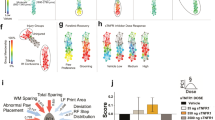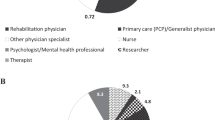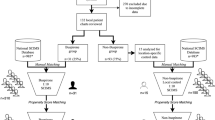Abstract
Study design:
Prospective controlled before-and-after study.
Objectives:
To investigate the effects of antimuscarinic treatment of neurogenic lower urinary tract dysfunction on the cognition of individuals with spinal cord injury (SCI) during the early post-acute phase.
Setting:
Single SCI rehabilitation center.
Methods:
Patients with acute traumatic SCI admitted for primary rehabilitation from 2011 to 2015 were screened for study enrollment. Study participants underwent baseline neuropsychological assessments prior to their first urodynamic evaluation (6–8 weeks after SCI). Individuals suffering from neurogenic detrusor overactivity received antimuscarinic treatment, and those not requiring antimuscarinic treatment constituted the control group. The neuropsychological follow-up assessment was carried out 3 months after the baseline assessment. The effects of group and time on the neuropsychological parameters were investigated.
Results:
The data of 29 individuals were evaluated (control group 19, antimuscarinic group 10). The group had a significant (P≤0.033) effect on immediate recall, attention ability and perseveration. In the control group, individuals performed significantly (P≤0.05) better in immediate recall both at baseline (percentile rank 40, 95% CI 21–86 versus 17, 95% CI 4–74) and follow-up (percentile rank 40, 95% CI 27–74 versus 16, 95% CI 2–74). The time had a significant (P≤0.04) effect on attention ability, processing speed, word fluency and visuospatial performance. The individuals in both groups performed better at the follow-up compared to the baseline assessment.
Conclusion:
Even though, we did not observe cognitive deterioration in the investigated, cognitively intact SCI individuals during the first 3 treatment months, the concerns regarding deleterious effects of antimuscarinics on cognition remain.
Similar content being viewed by others
Log in or create a free account to read this content
Gain free access to this article, as well as selected content from this journal and more on nature.com
or
References
Groen J, Pannek J, Castro Diaz D, Del Popolo G, Gross T, Hamid R et al. Summary of European Association of Urology (EAU) Guidelines on Neuro-Urology. Eur Urol. 2016; 69: 324–333.
Burns AS, Rivas DA, Ditunno JF . The management of neurogenic bladder and sexual dysfunction after spinal cord injury. Spine 2001; 26: S129–S136.
Wyndaele JJ . The management of neurogenic lower urinary tract dysfunction after spinal cord injury. Nat Rev Urol 2016; 13: 705–714.
Kessler TM, Bachmann LM, Minder C, Lohrer D, Umbehr M, Schunemann HJ et al. Adverse event assessment of antimuscarinics for treating overactive bladder: a network meta-analytic approach. PLoS ONE 2011; 6: e16718.
Chancellor M, Boone T . Anticholinergics for overactive bladder therapy: central nervous system effects. CNS Neurosci Ther 2012; 18: 167–174.
Collamati A, Martone AM, Poscia A, Brandi V, Celi M, Marzetti E et al. Anticholinergic drugs and negative outcomes in the older population: from biological plausibility to clinical evidence. Aging Clin Exp Res 2016; 28: 25–35.
Risacher SL, McDonald BC, Tallman EF, West JD, Farlow MR, Unverzagt FW et al. Association between anticholinergic medication use and cognition, brain metabolism, and brain atrophy in cognitively normal older adults. JAMA Neurol 2016; 73: 721–732.
Ruxton K, Woodman RJ, Mangoni AA . Drugs with anticholinergic effects and cognitive impairment, falls and all-cause mortality in older adults: a systematic review and meta-analysis. Br J Clin Pharmacol 2015; 80: 209–220.
Sakakibara R, Tateno F, Yano M, Takahashi O, Sugiyama M, Ogata T et al. Imidafenacin on bladder and cognitive function in neurologic OAB patients. Clin Auton Res 2013; 23: 189–195.
Veenboer PW, Huisman J, Chrzan RJ, Kuijper CF, Dik P, de Kort LM et al. Behavioral effects of long-term antimuscarinic use in patients with spinal dysraphism: a case control study. J Urol 2013; 190: 2228–2232.
Salahudeen MS, Duffull SB, Nishtala PS . Anticholinergic burden quantified by anticholinergic risk scales and adverse outcomes in older people: a systematic review. BMC Geriatr 2015; 15: 31.
Heaton RK, Miller SW, Taylor MJ, Grant I . Revised Comprehensive Norms for an Expanded Halstead Reitan6 Battery: Demographically Adjusted Neuropsychological Norms for African American and Caucasian Adults. Psychological Assessment Resources, Inc: Lutz. 2004.
Binder LM, Iverson GL, Brooks BL . To err is human: ‘abnormal’ neuropsychological scores and variability are common in healthy adults. Arch Clin Neuropsychol 2009; 24: 31–46.
DeVivo MJ, Biering-Sorensen F, New P, Chen Y . Standardization of data analysis and reporting of results from the International Spinal Cord Injury Core Data Set. Spinal Cord 2011; 49: 596–599.
Brunner E, Domhof S, Langer F . Nonparametric Analysis Of Longitudinal Data In Factorial Experiments. Wiley: New York. 2002.
Noguchi K, Gel YR, Brunner E, Konietschke F . nparLD: an R software package for the nonparametric analysis of longitudinal data in factorial experiments. J Stat Soft 2012; 50: 1–23.
Katz IR, Sands LP, Bilker W, DiFilippo S, Boyce A, D'Angelo K . Identification of medications that cause cognitive impairment in older people: the case of oxybutynin chloride. J Am Geriatr Soc 1998; 46: 8–13.
Kay G, Crook T, Rekeda L, Lima R, Ebinger U, Arguinzoniz M et al. Differential effects of the antimuscarinic agents darifenacin and oxybutynin ER on memory in older subjects. Eur Urol 2006; 50: 317–326.
Wesnes KA, Edgar C, Tretter RN, Bolodeoku J . Exploratory pilot study assessing the risk of cognitive impairment or sedation in the elderly following single doses of solifenacin 10 mg. Expert Opin Drug Saf 2009; 8: 615–626.
Lipton RB, Kolodner K, Wesnes K . Assessment of cognitive function of the elderly population: effects of darifenacin. J Urol 2005; 173: 493–498.
Kay GG, Maruff P, Scholfield D, Malhotra B, Whelan L, Darekar A et al. Evaluation of cognitive function in healthy older subjects treated with fesoterodine. Postgrad Med 2012; 124: 7–15.
Wagg A, Verdejo C, Molander U . Review of cognitive impairment with antimuscarinic agents in elderly patients with overactive bladder. Int J Clin Pract 2010; 64: 1279–1286.
Abrams P, Andersson KE . Muscarinic receptor antagonists for overactive bladder. BJU Int 2007; 100: 987–1006.
Beglinger LJ, Gaydos B, Tangphao-Daniels O, Duff K, Kareken DA, Crawford J et al. Practice effects and the use of alternate forms in serial neuropsychological testing. Arch Clin Neuropsychol 2005; 20: 517–529.
Bartels C, Wegrzyn M, Wiedl A, Ackermann V, Ehrenreich H . Practice effects in healthy adults: a longitudinal study on frequent repetitive cognitive testing. BMC Neurosci 2010; 11: 118.
Whyte E, Skidmore E, Aizenstein H, Ricker J, Butters M . Cognitive impairment in acquired brain injury: a predictor of rehabilitation outcomes and an opportunity for novel interventions. PM R 2011; 3: S45–S51.
Heruti RJ, Lusky A, Dankner R, Ring H, Dolgopiat M, Barell V et al. Rehabilitation outcome of elderly patients after a first stroke: effect of cognitive status at admission on the functional outcome. Arch Phys Med Rehabil 2002; 83: 742–749.
Craig A, Guest R, Tran Y, Middleton J . Cognitive impairment and mood states after spinal cord injury. J Neurotrauma 2017; 34: 1156–1163.
Nicholson Perry K, Nicholas MK, Middleton J . Spinal cord injury-related pain in rehabilitation: a cross-sectional study of relationships with cognitions, mood and physical function. Eur J Pain 2009; 13: 511–517.
Wilmot CB, Cope DN, Hall KM, Acker M . Occult head injury: its incidence in spinal cord injury. Arch Phys Med Rehabil 1985; 66: 227–231.
Wu J, Zhao Z, Sabirzhanov B, Stoica BA, Kumar A, Luo T et al. Spinal cord injury causes brain inflammation associated with cognitive and affective changes: role of cell cycle pathways. J Neurosci 2014; 34: 989–1006.
Author information
Authors and Affiliations
Corresponding author
Ethics declarations
Competing interests
The authors declare no conflict of interest.
Rights and permissions
About this article
Cite this article
Krebs, J., Scheel-Sailer, A., Oertli, R. et al. The effects of antimuscarinic treatment on the cognition of spinal cord injured individuals with neurogenic lower urinary tract dysfunction: a prospective controlled before-and-after study. Spinal Cord 56, 22–27 (2018). https://doi.org/10.1038/sc.2017.94
Received:
Revised:
Accepted:
Published:
Issue date:
DOI: https://doi.org/10.1038/sc.2017.94
This article is cited by
-
A systematic review of neurocognitive dysfunction with overactive bladder medications
International Urogynecology Journal (2021)
-
Multidimensional review of cognitive impairment after spinal cord injury
Acta Neurologica Belgica (2021)
-
A prospective cohort study investigating contributors to mild cognitive impairment in adults with spinal cord injury: study protocol
BMC Neurology (2020)



